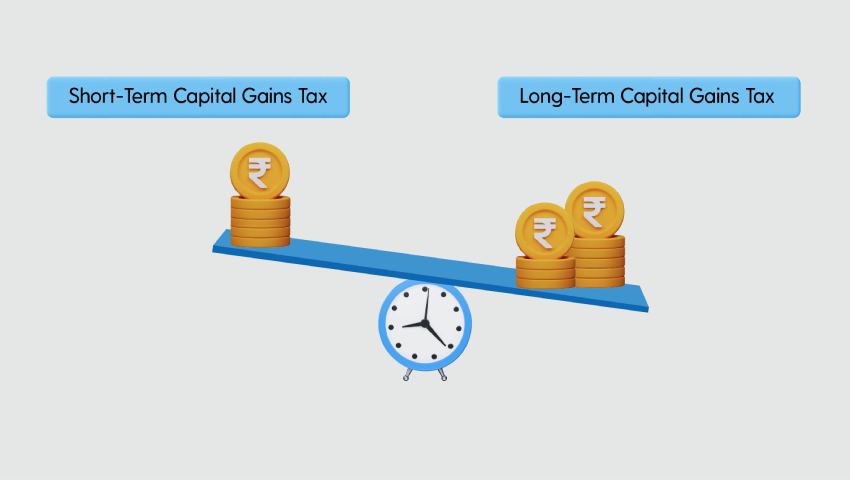
- 25/09/2025
- MyFinanceGyan
- 760 Views
- 3 Likes
- Tax, Share Market
STCG vs LTCG: A Complete Guide to Capital Gains Tax in India
Capital gains tax is one of the most important aspects of personal finance and investment planning in India. Whenever you sell an asset such as stocks, mutual funds, property, or gold at a profit, that gain becomes taxable. However, not all capital gains are taxed in the same way. The Indian tax system categorizes gains as either Short-Term Capital Gains (STCG) or Long-Term Capital Gains (LTCG) depending on how long you hold the asset before selling. This classification directly impacts the tax rate, exemptions, and ultimately your wealth-building strategy. This guide explains in detail:
- What STCG and LTCG mean
- Holding period rules for different assets
- Tax rates post Union Budget 2024
- Examples of calculations
- Key differences between STCG and LTCG
- Tax planning strategies and compliance tips
What Are Capital Gains?
A capital gain is the profit earned when you sell a capital asset at a higher price than its cost of acquisition.
Formula:
Capital Gain = Sale Price – (Purchase Price + Cost of Improvement + Transfer Expenses)
Capital assets include:
- Stocks and bonds
- Mutual funds (equity and debt)
- Real estate (land, flats, buildings)
- Gold, jewelry, and precious metals
The tax treatment depends primarily on the holding period of the asset.
Short-Term Capital Gains (STCG):
Definition:
STCG arises when you sell an asset within a relatively short period of acquisition.
Holding period rules:
- Equity shares & equity-oriented mutual funds: Up to 12 months
- Unlisted shares, real estate, gold, jewelry, debt funds: Up to 24 months
Key Features of STCG:
- Higher taxation: Short-term gains attract higher tax rates.
- No special exemptions: Few tax-saving provisions apply compared to LTCG.
- High volatility exposure: Gains depend heavily on short-term market movements.
Long-Term Capital Gains (LTCG):
Definition:
LTCG is applicable when assets are held for a longer period before being sold.
Holding period rules:
- Equity shares & equity-oriented mutual funds: More than 12 months
- Unlisted shares, real estate, gold, debt funds: More than 24 months
Key Features of LTCG:
- Preferential tax rates: Lower than STCG, encouraging long-term investing.
- Exemption benefits: Specific thresholds exempt a portion of gains.
- Aligned with wealth building: Long-term holding reduces market volatility risk.
Holding Period Summary:
Tax Rates: STCG vs LTCG (After Budget 2024):
STCG Tax Rates:
- Equity shares & equity-oriented mutual funds:
- Flat 20% (increased from 15% in Budget 2024)
- No indexation benefit
- Other assets (real estate, debt funds, gold, etc.):
- Taxed as per individual income tax slab (can go up to 30%)
LTCG Tax Rates:
- Equity shares & equity-oriented mutual funds:
- 12.5% on gains exceeding ₹1.25 lakh annually (exemption increased from ₹1 lakh)
- No indexation benefit (removed in Budget 2024)
- Other assets (real estate, gold, debt funds):
- 12.5% without indexation (earlier 20% with indexation benefit)
Calculation Examples:
Example 1: STCG on Equity:
- Purchase: ₹1,00,000 (Jan 2024)
- Sale: ₹1,30,000 (Oct 2024)
- Holding: 9 months → STCG
- Gain: ₹30,000
- Tax: ₹30,000 × 20% = ₹6,000
Example 2: LTCG on Equity within Exemption:
- Purchase: ₹1,00,000 (Jan 2023)
- Sale: ₹1,80,000 (Mar 2024)
- Holding: 14 months → LTCG
- Gain: ₹80,000
- Exemption: Up to ₹1.25 lakh → Tax = Nil
Example 3: LTCG above Exemption:
- Purchase: ₹2,00,000 (Jan 2023)
- Sale: ₹3,50,000 (Mar 2024)
- Gain: ₹1,50,000
- Exempt: ₹1,25,000
- Taxable: ₹25,000 × 12.5% = ₹3,125
Key Differences Between STCG and LTCG:
Budget 2024 – Key Impacts:
- STCG Rate Hike: Equity STCG tax increased from 15% to 20%.
- LTCG Exemption Raised: From ₹1 lakh to ₹1.25 lakh annually.
- Indexation Removed: Long-term assets now taxed at a flat 12.5%.
- Simplification: Uniform LTCG rate improves compliance and transparency.
Tax Planning Strategies:
For Short-Term Investors:
- Offset losses: Adjust STCG against both STCG and LTCG.
- Plan around slabs: Especially for non-equity assets.
- Asset choice: Favor equity for better tax treatment.
For Long-Term Investors:
- Use exemption limit: Spread gains across years to maximize ₹1.25 lakh benefit.
- Diversify assets: Balance between equity and non-equity considering tax rules.
- Hold strategically: Time disposals to qualify as LTCG.
Special Rules and Compliance:
Securities Transaction Tax (STT):
- 0.1% on delivery trades (buy & sell)
- 0.025% on intraday (sell only)
Set-Off Rules:
- STCG losses: Can offset against both STCG & LTCG
- LTCG losses: Can offset only against LTCG, carry forward for 8 years
Practical Tips for Investors:
- Maintain records: Keep track of purchase/sale prices, dates, brokerage, splits, and dividends.
- Use digital tools: Portfolio trackers simplify tax reporting.
- Seek expert advice: For complex portfolios and cross-year planning.
- Stay updated: Tax laws evolve regularly—follow Budget updates & SEBI guidelines.
Conclusion:
The distinction between Short-Term Capital Gains (STCG) and Long-Term Capital Gains (LTCG) is more than just about holding periods—it directly affects your tax liability, strategy, and wealth-creation potential.
Key Takeaways:
- Equity STCG taxed at 20%, LTCG taxed at 12.5% beyond exemption.
- Budget 2024 favors long-term investors with higher exemption limits.
- Proper planning—timing, diversification, and record-keeping—can significantly reduce tax outgo.
By understanding STCG and LTCG rules, investors can align their financial decisions with tax efficiency, regulatory compliance, and long-term wealth creation.
Disclaimer: This article is for educational purposes only and reflects the author’s personal views. It is not intended as tax advice or investment recommendations.



